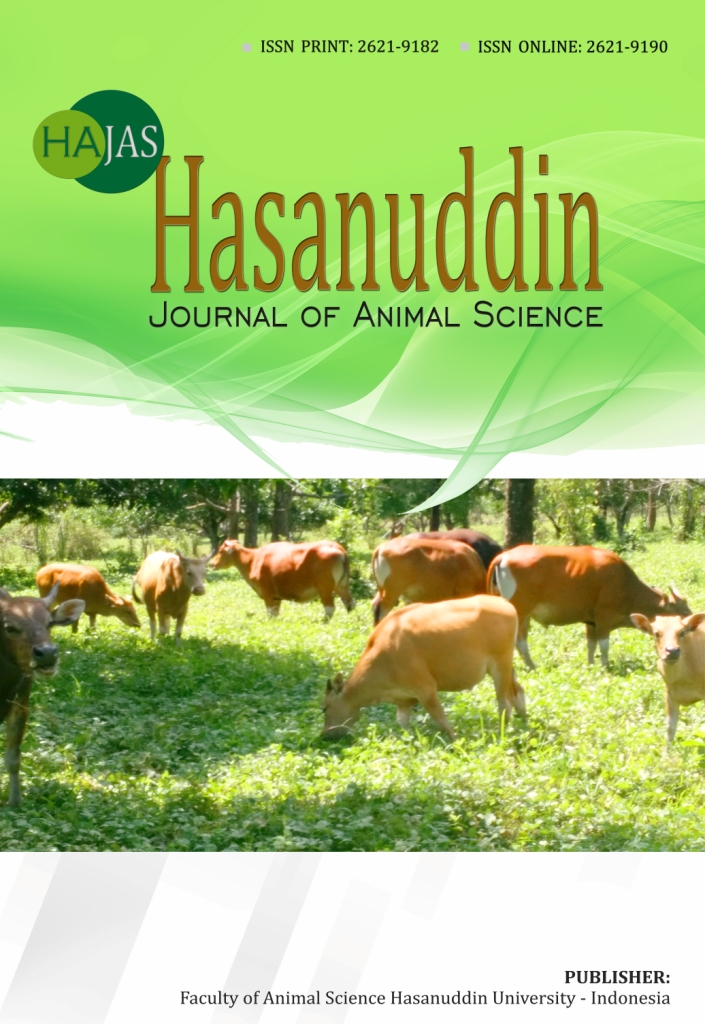Effect of substituting concentrate with dwarf Napier grass (Pennisetum purpureum) on intake, growth and carcass composition of rabbits
Keywords:
Carcass composition, dwarf Napier grass, growth performance, intake, rabbitAbstract
Dwarf Napier grass (Pennisetum purpureum) is considered to be more suitable as forage for ruminants due to its high yield and nutritive value, but there is limited research on rabbits. Thus, the aim of this study was to investigate the effect of replacing concentrate with dwarf Napier grass on intake, gorwth performance and carcass composition of growing rabbits. Twelve growing rabbits were randomly distributed into three dietary groups in a completely randomised design: (i) concentrate feed ad libitum as control diet (T1), (ii) half of the control diet plus dwarf Napier grass ad libitum (T2), and (iii) quarter of the control diet plus dwarf Napier grass ad libitum (T3). The results showed that diets had a significant (p<0.05) effect on intake, growth performance and some non-carcass components. Rabbits fed T3 diet showed significantly (p<0.05) lower total DM intake than those fed T1 and T2 diets. Similarly, rabbits fed T3 diet showed significantly (p<0.05) lower total weight gain and daily weight gain than those fed T1 diet, but the respective values of those fed T2 diet were non-signifiacntly different from those fed T1 and T3 diets. There was significant effect on weights of meat with bone, fat, pelt, head and kidney by the diets, whereas weights of most of the non-carcass components were similar among the groups. In conclusion, diet consisting of half of the concentrate and dwarf Napier grass ad libitum is recommended to be used as it may reduce the feed cost compared to diet consisting of the concentrate alone.
References
Amata, I. A. and Okorodudu, E.O. 2016. Comparative evaluation of the growth performance and feed intake of weaned rabbits fed tropical grasses and selected forage leaves. International Journal of Research Studies in Agricultural Sciences 2(2): 14–18.
AOAC (Association of Official Analytical Chemists). 2005. Official methods of analysis. 18th Edn. AOAC International, Arlington, VA, USA.
Fukagawa, S. and Ishii, Y. 2018. Grassland establishment of dwarf napiergrass (Pennisetum purpureum schumach) by planting of cuttings in the winter season. Agronomy 8(12): 1–10.
Halim, R.A., Shampazuraini, S. and Idris, A.B. 2013. Yield and nutritive quality of nine Napier grass varieties in Malaysia. Malaysian Journal of Animal Science 16(2): 37−44.
Ikyume, T.T., Ogu, I.E., Okwori, I.A. and Shaahu, D.T. 2019. Growth performance and apparent nutrient digestibility of grower rabbits fed combinations of concentrate with grass and/or legume forage. Journal of Multidisciplinary Research and Reviews 1(1): 41–45.
Iyeghe-Erakpotobor, G.T., Aliyu, R. and Uguru, J. 2003. Combinations of concentrate, grass and other forage mixtures for feeding grower rabbits. IN: Nigerian livestock: A goldmine for economic growth and food security. Eds: AA Taiwo, AM Raji, JU Ogbonna, EA Adebowale. Proc. 28th Ann. Conf. NSAP. Institute of Agricultural Research and Training, Obafemi Awolowo University, Ibadan, Nigeria. 16-20 March 2003. Pg 363–366.
Iyeghe-Erakpotobor, G.T., Osuhor, C.U. and Olugbemi, T.S. 2006. Performance and digestibility of weaner rabbits fed graded levels of soybean cheese waste/maize offal diet and brachiaria grass hay. African Journal of Biotechnology 5(17): 1579-1583.
Iyeghe-Erakpotobor, G. T. 2007. Effect of concentrate and forage type on performance and digestibility of growing rabbits under sub-humid tropical conditions. Asian Journal of Animal and Veterinary Advances 2(3): 125–132.
Onyimonyi, A.E. and Ene, J.C. 2003. Performance of growing rabbits fed Panicum maximum with graded levels of a concentrate diet. In: Sustainable livestock productivity and national development the holistic approach.Eds. EA Olatunji, BA. Ayanwale, EL Shiawoya, A Aremu Proc. 8th Ann. Conf., Anim. Sci. Ass. of Nig. (ASAN), Sept. 1518, 2003, Federal Univ. of Technology, Minna, Nigeria. pp. 73–75.
Owoleke, O.E., Tanimomo, B.K., Adama, T.Z., Akanya, H.O., Alemede, I.C., Abdulrahaman, M. and Kolawole, V.O. 2016. Feed evaluation and growth performance of rabbits fed diets containing different forages. Vom Journal of Veterinary Science 11(1): 101–111.
Rahman, M.M., Syafieqa, N.E., Diah, N.A.B.M., Gondo, T., Khalif, R.I.A.B.R. and Akashi R. 2019. Growth characteristics, biomass yield and mineral concentrations in seven varieties of Napier grass (Cenchrus purpureus) at establishment in Kelantan, Malaysia. Tropical Grasslands-Forrajes Tropicales 7(5): 538–543.
Safwat, A.M., Sarmiento-Franco, L., Santos-Ricalde, R. H. and Nieves, D. 2014. Determination of tropical forage preferences using two offering methods in rabbits. Asian-Australasian Journal of Animal Sciences 27(4): 524–529.
Downloads
Published
Issue
Section
License
Copyright (c) 2020 Hasanuddin Journal of Animal Science (HAJAS)

This work is licensed under a Creative Commons Attribution-NonCommercial 4.0 International License.











